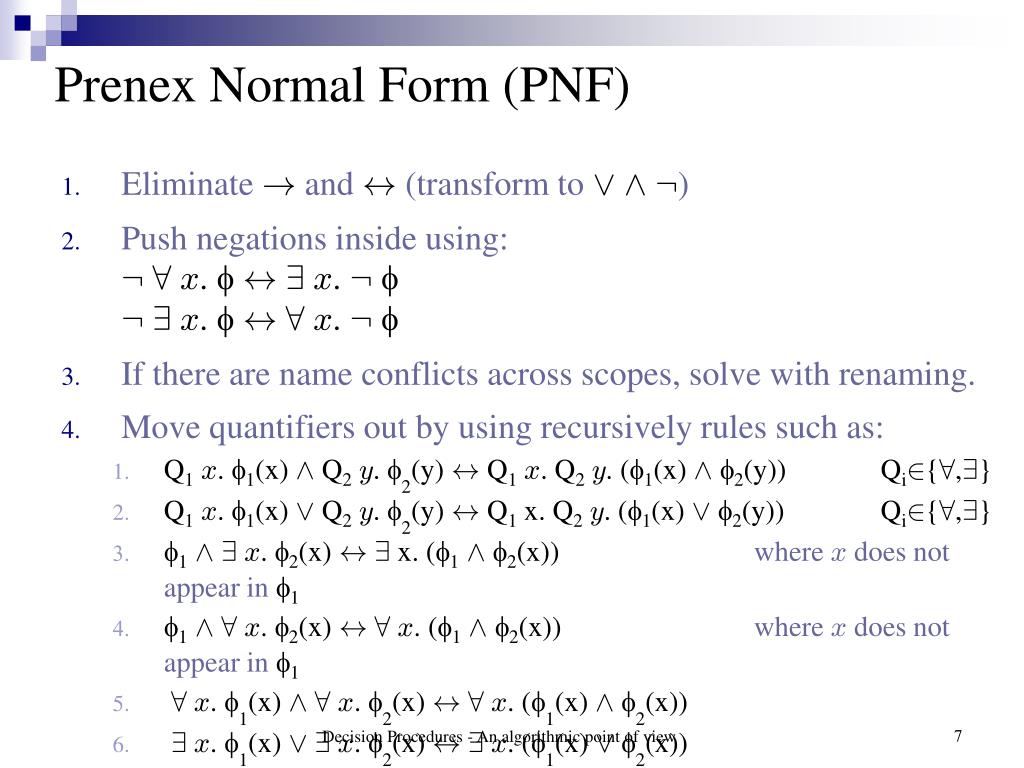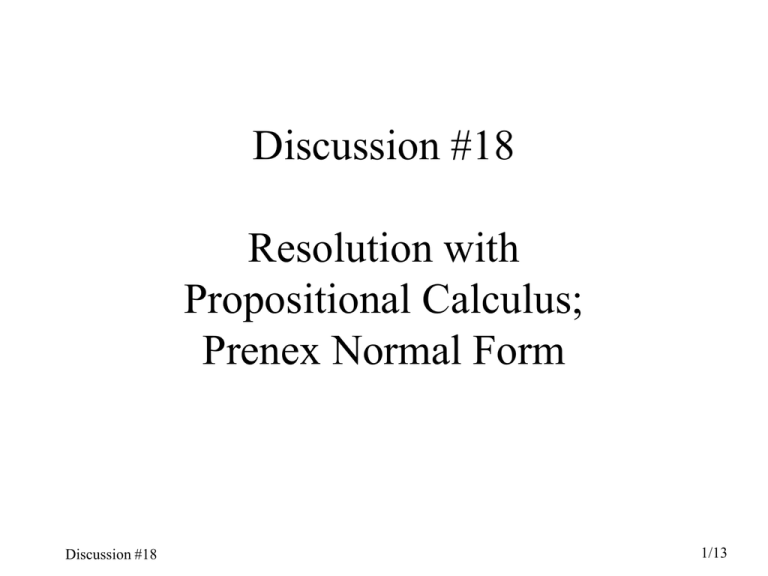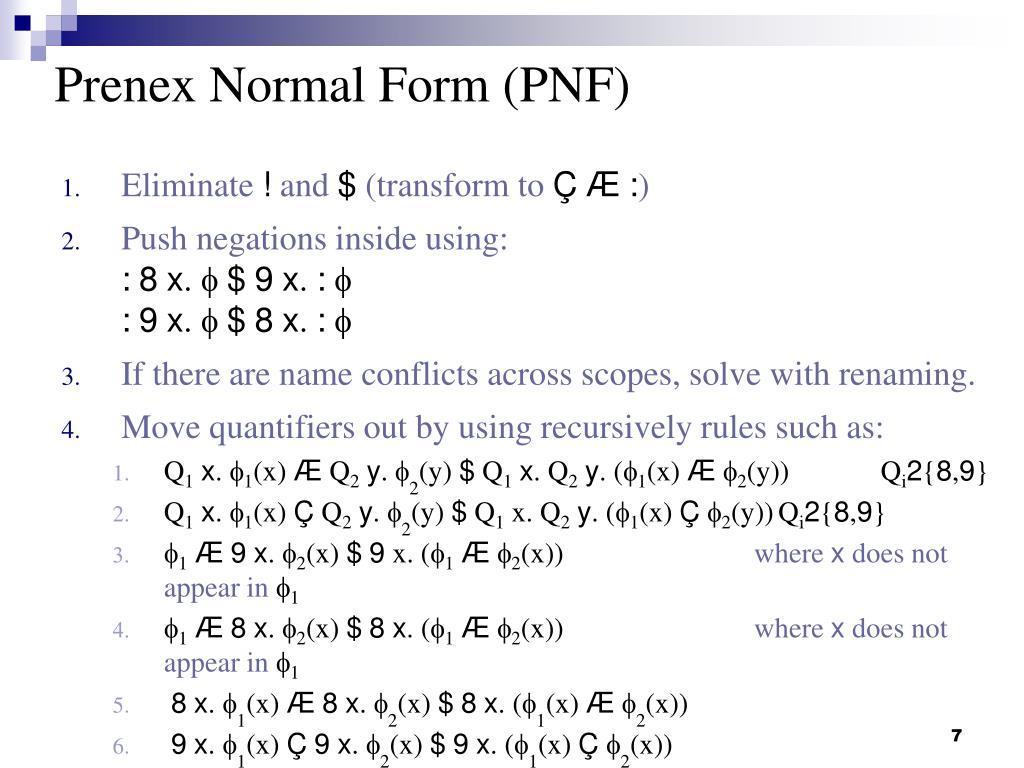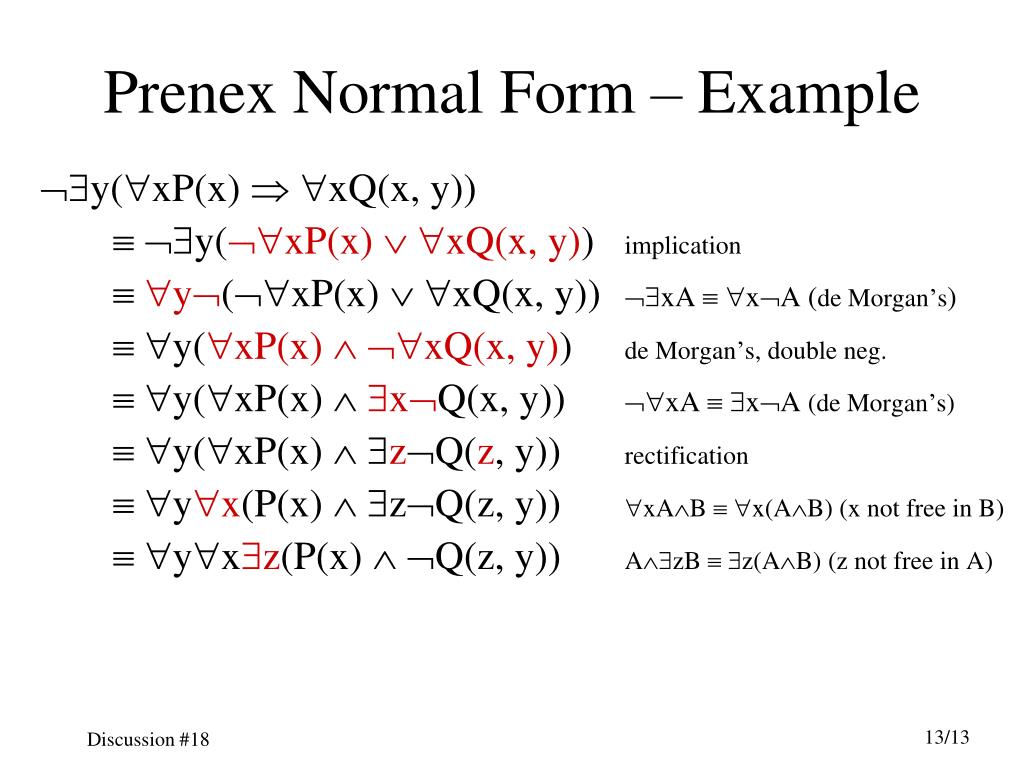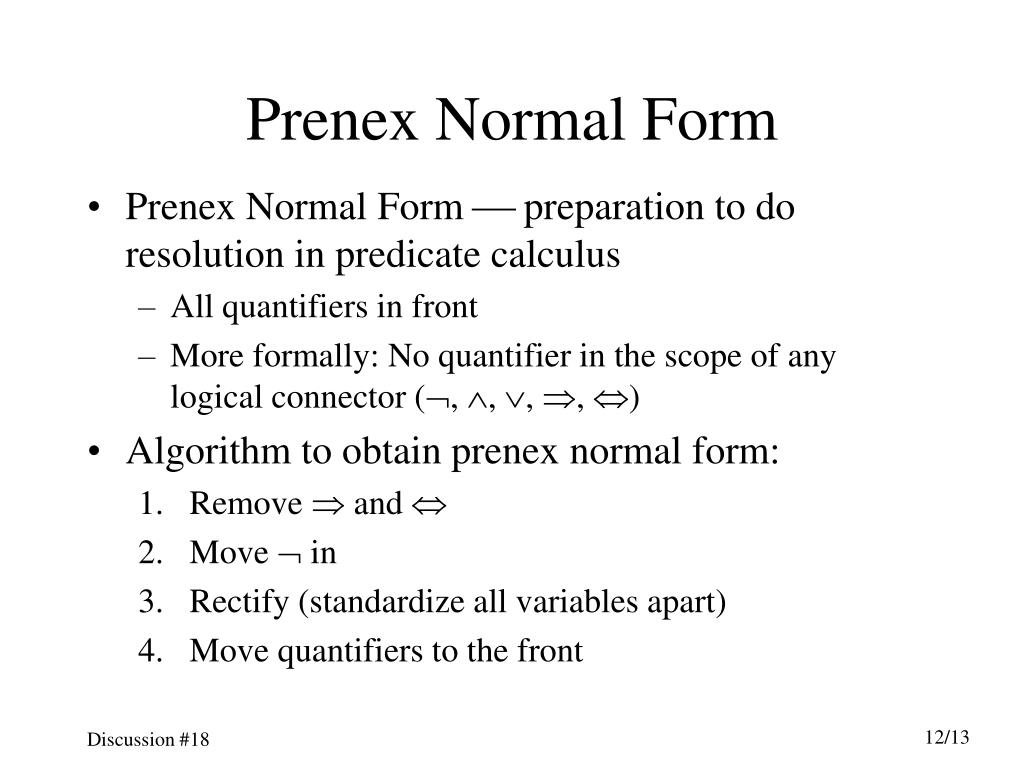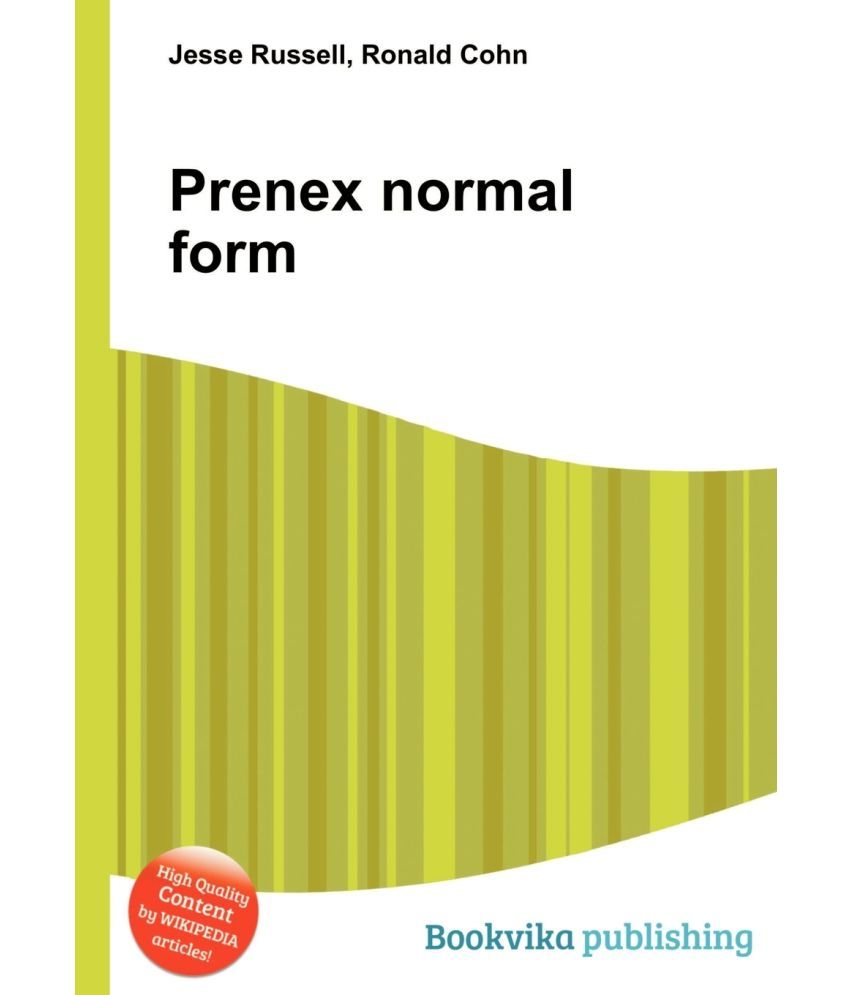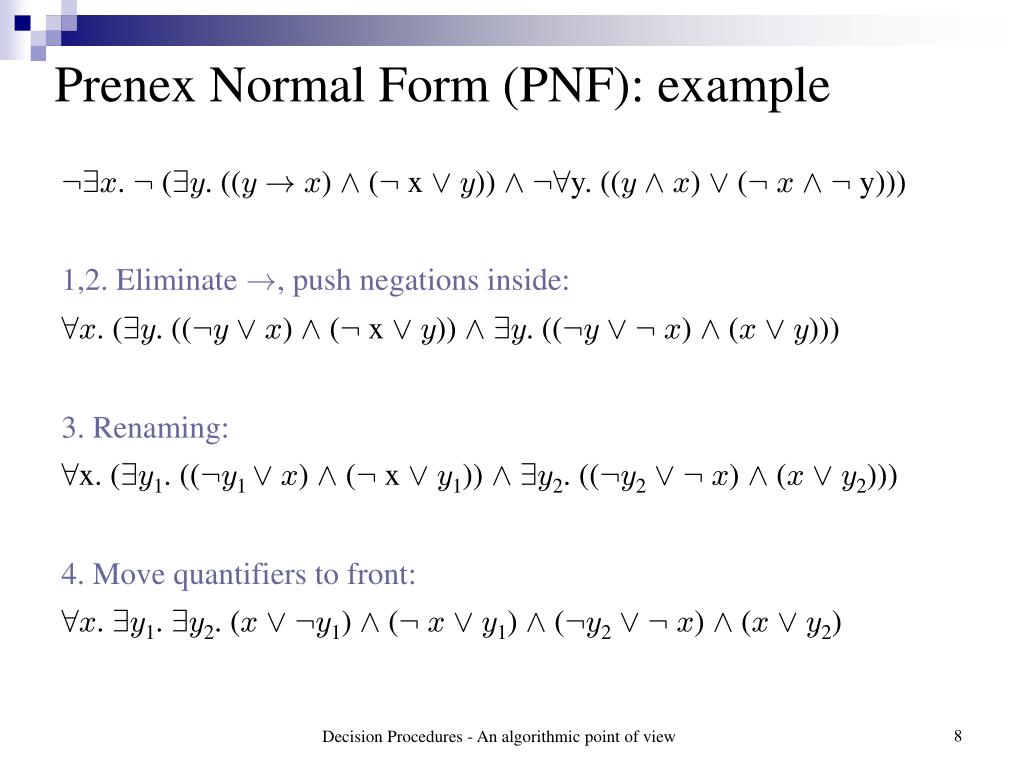Prenex Normal Form
Prenex Normal Form - Web theprenex normal form theorem, which shows that every formula can be transformed into an equivalent formula inprenex normal form, that is, a formula where all quantifiers appear at the beginning (top levels) of the formula. 8x9y(x>0!(y>0^x=y2)) is in prenex form, while 9x(x=0)^ 9y(y<0) and 8x(x>0_ 9y(y>0^x=y2)) are not in prenex form. Next, all variables are standardized apart: P ( x, y)) (∃y. Web i have to convert the following to prenex normal form. $$\left( \forall x \exists y p(x,y) \leftrightarrow \exists x \forall y \exists z r \left(x,y,z\right)\right)$$ any ideas/hints on the best way to work? P(x, y)) f = ¬ ( ∃ y. P ( x, y) → ∀ x. Web finding prenex normal form and skolemization of a formula. Web one useful example is the prenex normal form:
Web find the prenex normal form of 8x(9yr(x;y) ^8y:s(x;y) !:(9yr(x;y) ^p)) solution: :::;qnarequanti ers andais an open formula, is in aprenex form. 8x(8y 1:r(x;y 1) _9y 2s(x;y 2) _8y 3:r. Web one useful example is the prenex normal form: $$\left( \forall x \exists y p(x,y) \leftrightarrow \exists x \forall y \exists z r \left(x,y,z\right)\right)$$ any ideas/hints on the best way to work? P ( x, y)) (∃y. P ( x, y) → ∀ x. P(x, y)) f = ¬ ( ∃ y. 8x9y(x>0!(y>0^x=y2)) is in prenex form, while 9x(x=0)^ 9y(y<0) and 8x(x>0_ 9y(y>0^x=y2)) are not in prenex form. Web gödel defines the degree of a formula in prenex normal form beginning with universal quantifiers, to be the number of alternating blocks of quantifiers.
Is not, where denotes or. P ( x, y) → ∀ x. The quanti er stringq1x1:::qnxnis called thepre x,and the formulaais thematrixof the prenex form. Web gödel defines the degree of a formula in prenex normal form beginning with universal quantifiers, to be the number of alternating blocks of quantifiers. Every sentence can be reduced to an equivalent sentence expressed in the prenex form—i.e., in a form such that all the quantifiers appear at the beginning. According to step 1, we must eliminate !, which yields 8x(:(9yr(x;y) ^8y:s(x;y)) _:(9yr(x;y) ^p)) we move all negations inwards, which yields: 8x(8y 1:r(x;y 1) _9y 2s(x;y 2) _8y 3:r. Transform the following predicate logic formula into prenex normal form and skolem form: P(x, y)) f = ¬ ( ∃ y. He proves that if every formula of degree k is either satisfiable or refutable then so is every formula of degree k + 1.
PPT Quantified formulas PowerPoint Presentation, free download ID
According to step 1, we must eliminate !, which yields 8x(:(9yr(x;y) ^8y:s(x;y)) _:(9yr(x;y) ^p)) we move all negations inwards, which yields: Web i have to convert the following to prenex normal form. Transform the following predicate logic formula into prenex normal form and skolem form: Web prenex normal form. Web one useful example is the prenex normal form:
Prenex Normal Form
I'm not sure what's the best way. $$\left( \forall x \exists y p(x,y) \leftrightarrow \exists x \forall y \exists z r \left(x,y,z\right)\right)$$ any ideas/hints on the best way to work? Web gödel defines the degree of a formula in prenex normal form beginning with universal quantifiers, to be the number of alternating blocks of quantifiers. Every sentence can be reduced.
PPT Quantified Formulas PowerPoint Presentation, free download ID
Is not, where denotes or. This form is especially useful for displaying the central ideas of some of the proofs of… read more Web i have to convert the following to prenex normal form. Transform the following predicate logic formula into prenex normal form and skolem form: I'm not sure what's the best way.
PPT Discussion 18 Resolution with Propositional Calculus; Prenex
He proves that if every formula of degree k is either satisfiable or refutable then so is every formula of degree k + 1. Web gödel defines the degree of a formula in prenex normal form beginning with universal quantifiers, to be the number of alternating blocks of quantifiers. P ( x, y) → ∀ x. Web theprenex normal form.
PPT Discussion 18 Resolution with Propositional Calculus; Prenex
According to step 1, we must eliminate !, which yields 8x(:(9yr(x;y) ^8y:s(x;y)) _:(9yr(x;y) ^p)) we move all negations inwards, which yields: P ( x, y)) (∃y. I'm not sure what's the best way. Transform the following predicate logic formula into prenex normal form and skolem form: Web prenex normal form.
Prenex Normal Form Buy Prenex Normal Form Online at Low Price in India
Web theprenex normal form theorem, which shows that every formula can be transformed into an equivalent formula inprenex normal form, that is, a formula where all quantifiers appear at the beginning (top levels) of the formula. Web find the prenex normal form of 8x(9yr(x;y) ^8y:s(x;y) !:(9yr(x;y) ^p)) solution: He proves that if every formula of degree k is either satisfiable.
Prenex Normal Form YouTube
Web gödel defines the degree of a formula in prenex normal form beginning with universal quantifiers, to be the number of alternating blocks of quantifiers. P(x, y))) ( ∃ y. Web find the prenex normal form of 8x(9yr(x;y) ^8y:s(x;y) !:(9yr(x;y) ^p)) solution: According to step 1, we must eliminate !, which yields 8x(:(9yr(x;y) ^8y:s(x;y)) _:(9yr(x;y) ^p)) we move all negations.
(PDF) Prenex normal form theorems in semiclassical arithmetic
P ( x, y)) (∃y. The quanti er stringq1x1:::qnxnis called thepre x,and the formulaais thematrixof the prenex form. This form is especially useful for displaying the central ideas of some of the proofs of… read more Web i have to convert the following to prenex normal form. $$\left( \forall x \exists y p(x,y) \leftrightarrow \exists x \forall y \exists z.
logic Is it necessary to remove implications/biimplications before
According to step 1, we must eliminate !, which yields 8x(:(9yr(x;y) ^8y:s(x;y)) _:(9yr(x;y) ^p)) we move all negations inwards, which yields: :::;qnarequanti ers andais an open formula, is in aprenex form. A normal form of an expression in the functional calculus in which all the quantifiers are grouped without negations or other connectives before the matrix so that the scope.
PPT Quantified formulas PowerPoint Presentation, free download ID
Transform the following predicate logic formula into prenex normal form and skolem form: $$\left( \forall x \exists y p(x,y) \leftrightarrow \exists x \forall y \exists z r \left(x,y,z\right)\right)$$ any ideas/hints on the best way to work? Is not, where denotes or. P(x, y)) f = ¬ ( ∃ y. This form is especially useful for displaying the central ideas of.
He Proves That If Every Formula Of Degree K Is Either Satisfiable Or Refutable Then So Is Every Formula Of Degree K + 1.
I'm not sure what's the best way. Web i have to convert the following to prenex normal form. :::;qnarequanti ers andais an open formula, is in aprenex form. 8x(8y 1:r(x;y 1) _9y 2s(x;y 2) _8y 3:r.
P ( X, Y)) (∃Y.
Web finding prenex normal form and skolemization of a formula. According to step 1, we must eliminate !, which yields 8x(:(9yr(x;y) ^8y:s(x;y)) _:(9yr(x;y) ^p)) we move all negations inwards, which yields: Web one useful example is the prenex normal form: The quanti er stringq1x1:::qnxnis called thepre x,and the formulaais thematrixof the prenex form.
A Normal Form Of An Expression In The Functional Calculus In Which All The Quantifiers Are Grouped Without Negations Or Other Connectives Before The Matrix So That The Scope Of Each Quantifier Extends To The.
Web theprenex normal form theorem, which shows that every formula can be transformed into an equivalent formula inprenex normal form, that is, a formula where all quantifiers appear at the beginning (top levels) of the formula. $$\left( \forall x \exists y p(x,y) \leftrightarrow \exists x \forall y \exists z r \left(x,y,z\right)\right)$$ any ideas/hints on the best way to work? Every sentence can be reduced to an equivalent sentence expressed in the prenex form—i.e., in a form such that all the quantifiers appear at the beginning. Next, all variables are standardized apart:
This Form Is Especially Useful For Displaying The Central Ideas Of Some Of The Proofs Of… Read More
Is not, where denotes or. Web gödel defines the degree of a formula in prenex normal form beginning with universal quantifiers, to be the number of alternating blocks of quantifiers. Web find the prenex normal form of 8x(9yr(x;y) ^8y:s(x;y) !:(9yr(x;y) ^p)) solution: P(x, y)) f = ¬ ( ∃ y.
